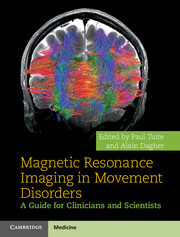Book contents
- Magnetic Resonance Imaging in Movement Disorders
- Magnetic Resonance Imaging in Movement Disorders
- Copyright page
- Contents
- Contributors
- Preface
- Abbreviations
- Key words
- Chapter 1 Magnetic resonance imaging (MRI) methods in Parkinson's disease
- Chapter 2 Imaging iron in Parkinson's disease
- Chapter 3 Motor Parkinson's disease and structure
- Chapter 4 MR imaging of Parkinson's disease with cognitive impairment and dementia
- Chapter 5 Functional MRI of motor signs in Parkinson’s disease
- Chapter 6 Functional MRI of cognition and mood in Parkinson’s disease
- Chapter 7 Networks and resting state in Parkinson’s disease
- Chapter 8 MRI for targeting in surgical treatment of movement disorders
- Chapter 9 Magnetic resonance imaging and spectroscopy in Huntington’s disease
- Chapter 10 Neuroimaging of Gilles de la Tourette syndrome
- Chapter 11 Dystonia
- Chapter 12 Tauopathies
- Chapter 13 Magnetic resonance imaging of multiple system atrophy
- Chapter 14 Ataxia
- Chapter 15 Magnetic resonance spectroscopy in Parkinson’s disease
- Chapter 16 The image of essential tremor: current neuroimaging and clues to disease localization, pathogenesis, and diagnosis
- Chapter 17 Clinical applications
- Chapter 18 MRI in clinical trials
- Index
Chapter 8 - MRI for targeting in surgical treatment of movement disorders
Published online by Cambridge University Press: 05 October 2013
- Magnetic Resonance Imaging in Movement Disorders
- Magnetic Resonance Imaging in Movement Disorders
- Copyright page
- Contents
- Contributors
- Preface
- Abbreviations
- Key words
- Chapter 1 Magnetic resonance imaging (MRI) methods in Parkinson's disease
- Chapter 2 Imaging iron in Parkinson's disease
- Chapter 3 Motor Parkinson's disease and structure
- Chapter 4 MR imaging of Parkinson's disease with cognitive impairment and dementia
- Chapter 5 Functional MRI of motor signs in Parkinson’s disease
- Chapter 6 Functional MRI of cognition and mood in Parkinson’s disease
- Chapter 7 Networks and resting state in Parkinson’s disease
- Chapter 8 MRI for targeting in surgical treatment of movement disorders
- Chapter 9 Magnetic resonance imaging and spectroscopy in Huntington’s disease
- Chapter 10 Neuroimaging of Gilles de la Tourette syndrome
- Chapter 11 Dystonia
- Chapter 12 Tauopathies
- Chapter 13 Magnetic resonance imaging of multiple system atrophy
- Chapter 14 Ataxia
- Chapter 15 Magnetic resonance spectroscopy in Parkinson’s disease
- Chapter 16 The image of essential tremor: current neuroimaging and clues to disease localization, pathogenesis, and diagnosis
- Chapter 17 Clinical applications
- Chapter 18 MRI in clinical trials
- Index
Summary
Keywords
- Type
- Chapter
- Information
- Magnetic Resonance Imaging in Movement DisordersA Guide for Clinicians and Scientists, pp. 94 - 105Publisher: Cambridge University PressPrint publication year: 2013

